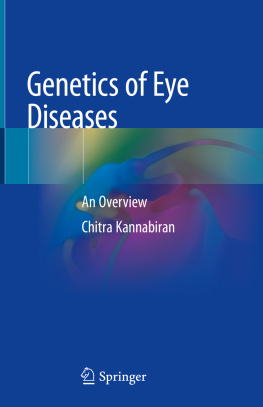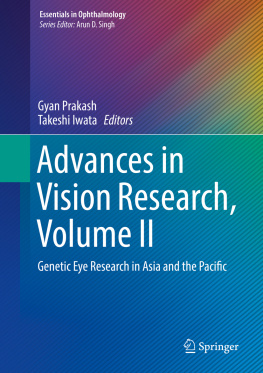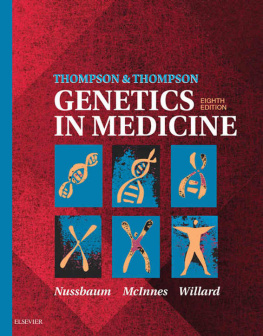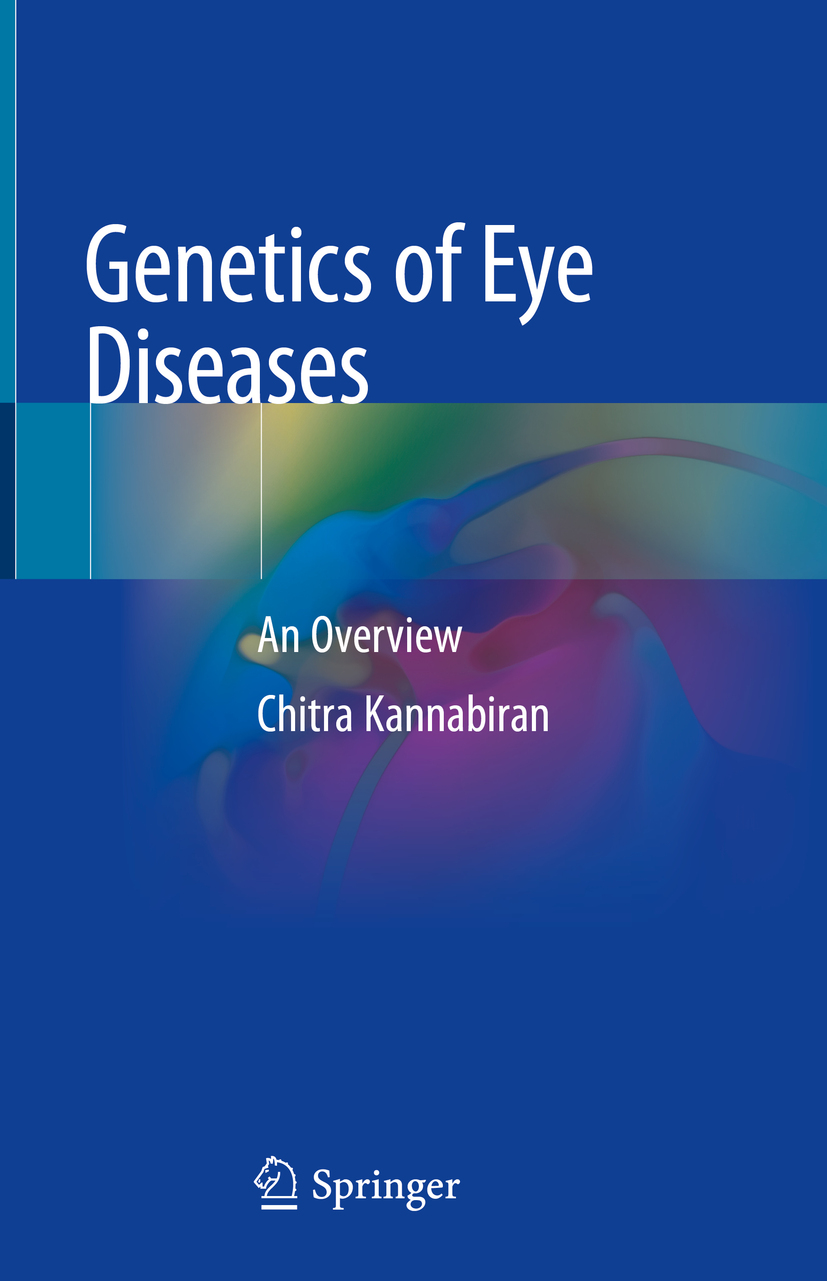Chitra Kannabiran
Genetics of Eye Diseases An Overview
Chitra Kannabiran
Kallam Anji Reddy Molecular Genetics Laboratory, L V Prasad Eye Institute (LVPEI), Hyderabad, India
ISBN 978-981-13-7145-5 e-ISBN 978-981-13-7146-2
https://doi.org/10.1007/978-981-13-7146-2
Springer Nature Singapore Pte Ltd. 2019
This work is subject to copyright. All rights are reserved by the Publisher, whether the whole or part of the material is concerned, specifically the rights of translation, reprinting, reuse of illustrations, recitation, broadcasting, reproduction on microfilms or in any other physical way, and transmission or information storage and retrieval, electronic adaptation, computer software, or by similar or dissimilar methodology now known or hereafter developed.
The use of general descriptive names, registered names, trademarks, service marks, etc. in this publication does not imply, even in the absence of a specific statement, that such names are exempt from the relevant protective laws and regulations and therefore free for general use.
The publisher, the authors, and the editors are safe to assume that the advice and information in this book are believed to be true and accurate at the date of publication. Neither the publisher nor the authors or the editors give a warranty, expressed or implied, with respect to the material contained herein or for any errors or omissions that may have been made. The publisher remains neutral with regard to jurisdictional claims in published maps and institutional affiliations.
This Springer imprint is published by the registered company Springer Nature Singapore Pte Ltd.
The registered company address is: 152 Beach Road, #21-01/04 Gateway East, Singapore 189721, Singapore
Preface
The Genetics of Eye Diseases is written as a broad overview of the field that attempts to capture salient aspects pertaining to the current state of knowledge in several major eye diseases. Since the subject of eye diseases is very vast, there are diseases that could not be included here, though they may be important causes of visual impairment and blindness and of scientific interest to many in the field. Knowledge of the genetic and molecular basis of various eye diseases has accumulated through studies done across the world over several decades on clinically defined families and populations, using methods of gene identification, and also of studying protein function, that have been continuously evolving over time. Thus, I have tried to present the genetics of each eye disease through a discussion of the discoveries made and the approaches used to arrive at the same. It has been said that every revolution in science is a revolution in method. Hence, looking at the methods used, however cursorily, can be a key to understanding the evolution of the field as a whole. Though I had to be necessarily selective (and brief) about the content, hopefully the major trends and features of the genetics of each of the diseases are captured. In fact, a major dilemma in writing the various chapters in the book has been in deciding which aspects to present and in how much detail. The chapters are organized disease-wise, and within each, there are sections on specific genes. The book is aimed at a more specialized reader and presupposes knowledge of the basic principles of genetics, which are not dealt with here. My journey in the genetics of eye diseases has been considerably enriched by collaborations and insights from several colleagues, both clinical and research faculty at LVPEI. I am especially thankful to Dr. Gullapalli N. Rao for the many valuable opportunities to learn and grow in this field. The idea of putting together this book came from my publishers, and I am thankful to particularly Mr. Naren Agarwal and Mr. Athiappan Kumar for their patience and persistence and in continually nudging me on to finish this despite many interruptions during the process. I am indebted to Ms. Sabera Banu, our librarian, for very readily and promptly fetching me the vast amount of literature as and when needed.
Chitra Kannabiran
Hyderabad, India
Introduction and Scope of the Book
The genetics of eye diseases is a field that encompasses a large number of independent areas, each of which is diverse and vast in its scope. It includes several diseases that affect each part of the eye, each disease in turn being defined by multiple genetic bases and pathways that lead to development of the specific disease. This book attempts to examine the genetics of several (though not all) major eye diseases with reference to the genes involved, genetic variants thereof, mechanisms of pathogenesis, and animal models that have been studied. The basic principles, especially in relation to the methods used, in discovering the genetics of these diseases are highlighted, but the content is aimed at providing an overview of the current status in the field. There is also a specific mention of genetics of disorders that are substantially characterized in Indian populations, but in some of the disorders, data on genetics is relatively little to devote a whole section to this aspect.
The spurt in the knowledge and understanding of human genetic diseases in general began with the availability of the sequence of the human genome in the public domain since the last two decades. Over this period, the identification of disease genes has been gained considerable momentum. This is especially true for the rare inherited familial diseases in which mutations in a single gene of major effect lead to the disease phenotype. The transformations in the field of human genetics that began with the sequence of the first human genome were equally enabled by rapid changes and innovations in sequencing technology. The advent of next-generation sequencing (NGS) made it possible to complete the sequencing of an entire genome in a day. At inception, next-generation sequencers had a capacity that was thousands of times that of the capillary-based conventional sequencers, which worked by Sangers sequencing method. Over time, there have been successive improvements in the capacity of NGS machines, and the output of sequence data is now in the range of gigabases (10 9 bases) to terrabases (10 12 bases) per run. Apart from the huge increase in throughput and reduction in time, this trend has been accompanied by decreasing costs and thus given rise to the idea of personal genomes. By 2015, commercial NGS had arrived at a price of $1000 for a human genome sequence, and costs have been further declining since then.
These developments have accelerated the pace of genetic discovery for human diseases. The terrain of NGS also extends to complex diseases wherein genome sequencing is employed to detect rare variants in the genome that give rise to phenotypes such as changes in gene expression or in transcription factor binding, and such rare variants are tagged by more common single-nucleotide polymorphisms (SNPs). Thus, the applications of whole exome sequencing as well as high-throughput multiplexed sequencing of several genes in parallel have resulted in several discoveries of new disease genes as well as in a more comprehensive appraisal of the role of known genes in the pathogenesis of many eye diseases.
In this scenario, we are still in the midst of a continuous and robust growth in the understanding of the genetics of various eye diseases. Due to the vast and evolving nature of the subject areas involved, the purpose of the text is to highlight the first discoveries in each of the fields as well as a few representative studies that have dealt with the aspects mentioned above. Hopefully, the salient features and key trends of the genetics in relation to each disease and gene that is included here are captured.









